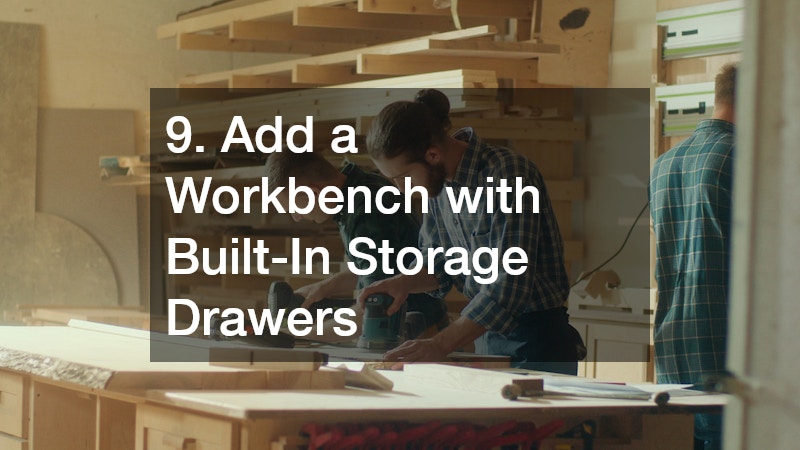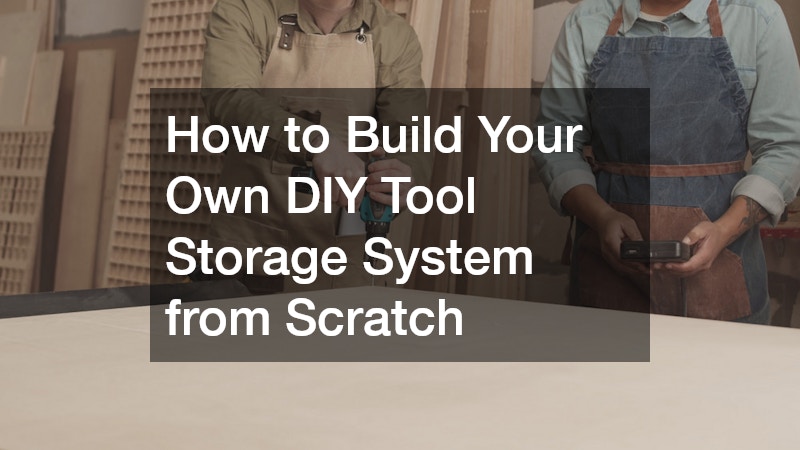
Maintaining an organized and clutter-free workshop can feel like an endless battle—especially for homeowners who juggle multiple projects and tool collections. Whether you’re a seasoned DIYer or just getting into home repairs, tool storage is essential to efficiency, safety, and creativity. Without the right system, it’s easy to waste time hunting for tools buried under piles of hardware or tucked into random drawers. But with the right tool storage ideas, you can transform your space into a streamlined, functional, and inspiring work area.
In this article, we’ll walk you through 10 genius tool storage ideas that will help you declutter and take control of your workshop. From space-saving wall solutions to mobile storage units and upcycled systems, you’ll discover practical tips that cater to every workshop size and budget.
1. Why Workshop Organization Matters: Save Time, Space, and Stress
Before diving into the specifics, let’s address the elephant in the room: Why does tool storage matter so much?
An organized workshop not only helps you find tools faster, but it also reduces safety hazards and boosts productivity. Cluttered surfaces, tangled cords, and poorly stored power tools can lead to accidents or damage to expensive equipment. And if you’re short on space, having a clean, intentional layout can make even a compact area feel spacious and functional.
Ask yourself:
- Do I frequently lose track of tools I know I have?
- Does my workspace feel overwhelming or hard to clean?
- Have I accidentally bought duplicate tools because I couldn’t find the original?
If the answer is yes, it’s time to rethink your tool storage strategy.
2. Use Vertical Space: Wall-Mounted Pegboards and Panels

One of the most effective ways to free up workbench and floor space is to take your storage vertical. Wall-mounted pegboards, slat walls, or French cleat systems allow you to store tools where they’re easily visible and accessible.
Why it works:
- Tools are displayed instead of hidden.
- Pegboards can be easily reconfigured as your tool collection grows.
- Reduces clutter on surfaces and improves workflow.
Pro Tip: Label tool outlines on your pegboard using a marker or painter’s tape. This makes it obvious when something is missing and encourages you to return tools to their proper spot.
Good For:
- Hammers
- Screwdrivers
- Wrenches
- Pliers
3. Invest in a Rolling Tool Cabinet
If you’re serious about your tools, a rolling tool chest is one of the best investments you can make. These mobile cabinets combine drawer organization with portability, making them ideal for homeowners who like to move their work zone.
Advantages:
- Lockable drawers keep tools secure.
- Smooth-rolling casters provide mobility across floors.
- Durable construction protects heavy-duty tools.
Look for units with ball-bearing drawer slides and rubber mats inside to prevent tool slippage.
4. Overhead Tool Storage Ideas for Seasonal or Rarely Used Tools
Have tools you don’t use often? Think above the obvious.
Try:
- Ceiling-mounted shelves or overhead racks.
- Pulley-operated storage lifts.
- Hanging bins suspended from ceiling joists.
This type of tool storage idea helps you make use of underutilized vertical space and keeps less-used items out of the way while still accessible when needed.
Great For:
- Seasonal power tools (like snowblowers or leaf vacuums)
- Extra toolboxes
- Large cases for specialty equipment
5. Create a Dedicated Tool Wall with French Cleats
French cleats are a more flexible and heavy-duty alternative to pegboards. This system uses a series of interlocking angled wood strips that allow you to mount shelves, tool holders, and bins in endless combinations.
Benefits:
- Holds more weight than a pegboard.
- Easily reposition shelves or hooks without tools.
- Perfect for evolving workshops with expanding tool collections.
You can even customize tool holders to perfectly fit your most-used gear using plywood and a jigsaw.
6. DIY Magnetic Tool Strips for Metal Tools
If you frequently reach for the same set of wrenches or screwdrivers, a magnetic strip mounted on a wall or the side of your workbench offers quick access.
Why magnetic storage works:
- Saves drawer space.
- Tools snap in place instantly—no hooks or holders needed.
- Keeps sharp items like chisels or drill bits visible and organized.
Installation Tip: Make sure to mount your magnetic strip into studs or with strong wall anchors for safety. Choose heavy-duty magnetic strips designed to hold several pounds each.
7. Use Clear Stackable Bins and Labels for Small Parts
Screws, bolts, washers, and other fasteners are notorious for causing clutter. Instead of tossing them all into a drawer, organize them using clear stackable bins with labels.
What to look for:
- Transparent containers for easy viewing.
- Removable dividers for adjustable compartments.
- Stackable design to save shelf space.
Use a label maker or masking tape and marker to clearly identify what’s inside. For bonus efficiency, sort by size and category (e.g., 1″ drywall screws, ¼” washers, masonry nails).
8. Convert an Old Filing Cabinet into Tool Storage
Don’t toss that old metal filing cabinet—repurpose it into a vertical tool locker.
How to do it:
- Remove unnecessary drawers or convert them into deeper storage.
- Add foam inserts or tool trays for organization.
- Mount magnetic strips or pegboard panels to the inside of doors.
This is a great budget-friendly way to add serious storage without buying new units. Filing cabinets are also very sturdy and lockable, making them ideal for valuable tools.
9. Add a Workbench with Built-In Storage Drawers

Your workbench is the heart of your workshop, so it makes sense to turn it into a multifunctional storage powerhouse. If you’re building or replacing your bench, choose one with built-in drawers, cabinets, and shelving.
Features to consider:
- Full-extension drawers for easy access.
- Heavy-duty construction to support tool weight.
- Adjustable shelves for bulkier items.
Alternatively, you can retrofit your current workbench by installing sliding drawer units, hanging bins, or cabinet doors underneath.
Bonus Tip: Add a power strip to the side of your bench to plug in tools and chargers conveniently.
10. Tool Storage Ideas for Garden and Outdoor Tools
If you have a shed or garage filled with rakes, shovels, and power trimmers, you know how fast outdoor tools can create chaos. The solution? Vertical hanging storage and wall-mounted racks.
Try:
- Wall hooks for long-handled tools.
- PVC pipe holders mounted at an angle.
- Garden tool towers with rotating bases.
These tool storage ideas not only save floor space but also prevent tools from falling or becoming damaged. Combine them with weatherproof containers for storing seeds, gloves, and other garden supplies.
How Can You Repurpose Everyday Items for Creative Tool Storage?
Not every great tool storage solution requires a trip to the hardware store. In fact, some of the best ideas come from repurposing everyday household items. Think muffin tins for sorting screws and nails, magnetic spice jars for small fasteners, or old wooden crates stacked and labeled for easy access to larger hand tools. Even a simple over-the-door shoe organizer can be used to store spray cans, pliers, and measuring tapes.
Repurposing not only saves money but also promotes sustainability by giving new life to unused items. The key is to think outside the box and look at common objects as potential storage helpers. Keep in mind that these solutions are especially useful for beginners who may not yet have the budget for advanced tool cabinets or custom workshop installations.
Should You Consider Digital Inventory for Your Tool Collection?
While physical organization is crucial, digitally tracking your tools can take your workshop management to the next level. Apps and spreadsheets allow you to log tool names, purchase dates, model numbers, warranty information, and even storage locations. This is especially useful if you lend out tools to neighbors or store equipment across multiple locations (like a garage and a shed). Some apps even let you snap a photo of each tool and add notes. Digital inventories are also invaluable for insurance purposes in case of theft or damage.
By combining smart physical storage with a digital system, homeowners can ensure every tool is accounted for and properly maintained over time. It may take an hour or two to set up, but the long-term benefits are worth the effort.
Bonus: Mobile Tool Carts and Workstations
If you like to move your workspace around, a mobile tool cart gives you portability without sacrificing organization. These wheeled units come with drawers, trays, and often even integrated power outlets.
Use them for:
- Electrical tools and cords.
- Plumbing supplies and kits.
- Painting equipment.
Keep each cart dedicated to a type of project so you can roll out exactly what you need for each job.
What Are the Best Tool Storage Ideas for Small Spaces?
For homeowners working in a compact garage, basement corner, or garden shed, tool storage needs to be smart, compact, and multifunctional. Here are some top solutions:
- Wall-mounted pegboards with baskets.
- Folding workbenches with storage.
- Compact drawer units under counters.
- Pegboard tool cabinets that close to hide clutter.
Focus on tools you use the most, and store bulkier or infrequently used items elsewhere. This reduces the need for oversized cabinets that eat up space.
How Often Should You Reorganize Your Tool Storage?
Tool organization isn’t a one-and-done job. To maintain an efficient and clutter-free workspace:
- Reassess every 6 months. Move tools you use frequently to more accessible spots.
- Purge duplicates or broken items. Don’t keep tools you never use.
- Update labels and containers. Ensure everything is easy to find.
- Clean surfaces. Wipe down drawers, shelves, and handles to keep your space safe.
The more often you tidy up, the easier it becomes to maintain order long-term.
Conclusion: Turn Your Workshop into a Productivity Zone
A clutter-free workshop isn’t just nice to look at—it’s a space that empowers you to do your best work. With the right tool storage ideas, you’ll spend less time searching and more time building. Whether you’re working with a small garage or a full basement shop, the key is to use space intentionally and find a system that works for your needs.
Remember, good organization is not about perfection—it’s about creating a space that serves you and your projects. Start with just one or two of these genius storage ideas and build from there.
Your tools—and your future projects—will thank you.

